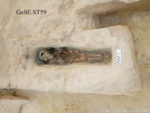 Archaeologists have discovered four intact child burials in the 18th Dynasty necropolis at Gebel el-Silsila in the Aswan region of Egypt. Excavated by Lund University archaeologists with the Swedish-Egyptian archaeological mission in collaboration with the Ministry of Antiquities, first found the large necropolis last year and returned this year to explore it further.
Archaeologists have discovered four intact child burials in the 18th Dynasty necropolis at Gebel el-Silsila in the Aswan region of Egypt. Excavated by Lund University archaeologists with the Swedish-Egyptian archaeological mission in collaboration with the Ministry of Antiquities, first found the large necropolis last year and returned this year to explore it further.
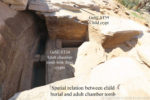 The necropolis dates to the Thutmosid period, from the reign of Thutmose II in 1493 B.C. through that of his grandson Amenhotep II around 1401 B.C., a time when Gebel el-Silsila was in active use as stone quarry. Fewer than half of the 69 crypts and burial chambers discovered there so far have been excavated, and most of them were looted and damaged in antiquity. The four child burials, on the other hand, were not plundered which gave the team the rare opportunity to examine grave goods and human remains that are usually scattered and/or destroyed.
The necropolis dates to the Thutmosid period, from the reign of Thutmose II in 1493 B.C. through that of his grandson Amenhotep II around 1401 B.C., a time when Gebel el-Silsila was in active use as stone quarry. Fewer than half of the 69 crypts and burial chambers discovered there so far have been excavated, and most of them were looted and damaged in antiquity. The four child burials, on the other hand, were not plundered which gave the team the rare opportunity to examine grave goods and human remains that are usually scattered and/or destroyed.
 Burial ST59 was a crypt cut into the rock of the quarry walls in which the remains of a very young child, around 2-3 years old at time of death, were buried. The child was wrapped in linen and placed in what archaeologists believe was a wooden coffin. All that it’s left of it now is some organic crumbles so they can’t be sure what it was. The team thinks it was a wooden sarcophagus that was devoured by termites. It was covered by a sandstone lid that survived but in very poor condition. There were no grave goods and early osteological examination has not been able to determine cause of death.
Burial ST59 was a crypt cut into the rock of the quarry walls in which the remains of a very young child, around 2-3 years old at time of death, were buried. The child was wrapped in linen and placed in what archaeologists believe was a wooden coffin. All that it’s left of it now is some organic crumbles so they can’t be sure what it was. The team thinks it was a wooden sarcophagus that was devoured by termites. It was covered by a sandstone lid that survived but in very poor condition. There were no grave goods and early osteological examination has not been able to determine cause of death.
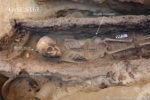 Child burial ST63 was an inhumation in a wooden sarcophagus of a child between six and nine years old. The coffin was sealed with mud and positioned with the head to the east facing due north. While it was untouched by human interference, the annual flooding of the Nile, the high salt content in the air and a proliferation of beetles saw to it that the mud-sealed coffin suffered heavy damage. The
Child burial ST63 was an inhumation in a wooden sarcophagus of a child between six and nine years old. The coffin was sealed with mud and positioned with the head to the east facing due north. While it was untouched by human interference, the annual flooding of the Nile, the high salt content in the air and a proliferation of beetles saw to it that the mud-sealed coffin suffered heavy damage. The 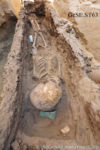 beetles did extensive redecoration, in fact. They moved nefer-amulet from one location to the child’s chest where the archaeologists found it. Other grave goods buried with the little one included bronze bracelets and four scarabs amulets on the left wrist, a bronze razor wedged under the back of the head and an impressive collection of 10 ceramic vessels (beer jars, colorful bowls, plates).
beetles did extensive redecoration, in fact. They moved nefer-amulet from one location to the child’s chest where the archaeologists found it. Other grave goods buried with the little one included bronze bracelets and four scarabs amulets on the left wrist, a bronze razor wedged under the back of the head and an impressive collection of 10 ceramic vessels (beer jars, colorful bowls, plates).
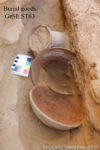 ST64 was the inhumation of a child around 5-8 years old. There was no coffin, present or suggested. The body was wrapped in linen and laid to rest at the bottom of the tomb on a reed mats. The child was buried with three scarabs and one ceramic piece that at some point had moved and was no longer in its original spot.
ST64 was the inhumation of a child around 5-8 years old. There was no coffin, present or suggested. The body was wrapped in linen and laid to rest at the bottom of the tomb on a reed mats. The child was buried with three scarabs and one ceramic piece that at some point had moved and was no longer in its original spot.
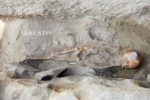 The last child burial, ST69, was of a child between five and eight years old. It was a neglected burial, done with little care in an area that was still being quarried at the time. The body was put in the grave without goods, coffin or even a shroud and the grave filled in with rock spoil from the quarry work. Osteological examination found signs of illness.
The last child burial, ST69, was of a child between five and eight years old. It was a neglected burial, done with little care in an area that was still being quarried at the time. The body was put in the grave without goods, coffin or even a shroud and the grave filled in with rock spoil from the quarry work. Osteological examination found signs of illness.
“The team is excited about continuing the osteological analysis of the remains, which will hopefully provide us with more specific details regarding nutrition and the general health and well-being of the children,” lead archaeologists Maria Nilsson and John Ward of Lund University in Sweden wrote in an email to Live Science.
Gebel el Silsila was once thought to be a place where workers toiled and not much else happened — a site of “slaves and simple workers,” Nilsson and Ward said. But the excavations on the east bank of the Nile River have revealed a much richer picture of life at the quarry. In 2016, the same researchers reported the discovery of 42 tombs, mostly empty, and a shrine. They’ve also discovered the carved statues of a man named Neferkhewe and his family. In total, Nilsson and Ward said, the team has excavated almost 30 of the 69 tombs discovered, including two belonging to infants. […]
The research team plans to further analyze the bones found in the graves, Ward and Nilsson said.
“The importance of these child burials is first and foremost that they provide the team with a possibility to study completely preserved inhumations, giving insights into the burial customs and pathological information, but they are also a strong indication of the existence and activity of complete families on site,” they wrote to Live Science.
Is it just me or do the skulls of the children in the first couple photographs look larger than normal?
..skulls of the children in the first couple photographs look larger than normal?’
—
Maybe … but children with ‘bigger heads’ are actually quite normal, that is also -just to give an example here- why toddlers have a tendency to ‘toddle’ (and sometimes they even fall over) 👿
The rest might be simply due to excessive use of the ‘impressive collection of 10 ceramic vessels’ and possibly those beer jars.
The razor, on the other hand, is not really a surprise, as -to the best of my knowledge- young Egyptian ‘hypertrophed kephaloi’ were regularly shaved.